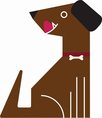Raw or cooked homemade food has a very high bioavailability and is very easily digestible for our carnivorous dogs and cats. The fine powder consistency of the food ingredients in our premix AND the inclusion of digestive enzymes in our product further contribute to your dog getting the most out of this food. The result is that most dogs do not need to eat as many calories when eating food made with EZComplete when compared to the canned food or kibble they were eating.
Please note we provide general guidelines. You may want to consult your trusted veterinarian for your dog’s specific requirements.
Feeding Guidelines
Puppies should be fed as much as they want at each meal, 3 to 4 times a day until 6 months of age, when feedings can be reduced to twice daily. As the growth slows down, please reduce the amount of food accordingly.
Pregnant & Lactating Dogs
Your dog does not require nearly the same amount of calories and nutrition during her pregnancy as she does when she is lactating. To avoid overfeeding your pregnant dog, and underfeeding your lactating mom, we recommend the following feeding guidelines. Of course, it is best to discuss the appropriate amount of food for your dog with your trusted veterinarian.
The Pregnant Dog. Your pregnant dog's calorie needs don't change much the first month of her pregnancy. She should be fed the normal amount of food for an adult dog the first 4 weeks. Her pregnancy will last (on average) 58 to 68 days. The second half of the gestational period is when her nutritional need begins to rise. From the 5th week until she gives birth, gradually increase the amount of food, targeting 25% – 30% more food by the time of delivery. It is best to increase her intake by feeding small but frequent meals.
The Lactating Dog. As soon as your mom gives birth and begins to nurse her puppies, her nutritional need increases tremendously. Your nursing mum will typically need two to three times her prior average daily calorie need. In short, she should have a frequently available, if not constant, supply of fresh food.
Raw-fed Adult Dogs typically eat between 2% - 4% of their body weight daily. Unless your dog is very active (or suffers from a gastrointestinal disease that causes malabsorption or improper digestion), eating 4% is unusual. Generally speaking, dogs eating raw food will consume between 2% - 3% of their body weight to maintain a healthy, ideal weight. Age, level of activity, and health status will all impact the amount of food your dog needs. For adult dogs, we recommend dividing the daily food requirement into two meals per day, usually fed morning and evening.
How does this translate into amounts?
A ten pound dog (4.5kg) at 2% will eat about 3 ¼ ounces (90g) of food a day:
(10 pounds x 16 ounces per pound = 160 ounces. 160oz x 0.02 = 3 ¼ ounces).
4.5 kilograms X 1,000 grams per kilogram = 4500 grams. 4500g x 0.02 = 90 grams).
A ten pound dog (4.5kg) at 3% will eat close to 5 ounces (135g) of food a day;
A (very very active!) ten pound dog (4.5kg) at 4% will eat about 6.5 ounces (180g) of food a day.
A twenty pound dog (9kg) at 2% will eat about 6.4 ounces (180g) a day;
A twenty pound dog (9kg) at 3% will eat about 9.6 ounces (272g) a day;
A (tremendously active!) twenty pound dog (9kg) at 4% will eat about 12.8 ounces (360g) a day.
A thirty pound dog (13.6kg) at 2% will eat about 9.6 ounces (272g) per day;
A thirty pound dog (13.6kg) at 3% will eat about 14.4 ounces (408g) per day;
An exceptionally active thirty pound dog (13.6kg) at 4% will eat about 19.2 ounces (545g) per day.
First, determine the amount of food that keeps your dog's weight stable. We recommend feeding your dog at 2.5% initially. It is important to weigh your dog weekly for the first two months to monitor whether your dog's weight is stable, rising, or falling on the amount of food being fed. Adjust the amount of food you are feeding until you find the amount that maintains a stable weight.
If your dog needs to gain weight, once you know the amount of food that keeps your dog's weight stable, you can slowly increase the amount until the target weight is achieved.
If your dog needs to lose weight, once you know the amount of food that keeps your dog's weight stable, you can slowly decrease the amount until the target weight is reached.
We encourage you to work with your vet during any weight change program for your dog. It is extremely important to identify any health issues that may be contributing to your pet being over- or under-weight.
